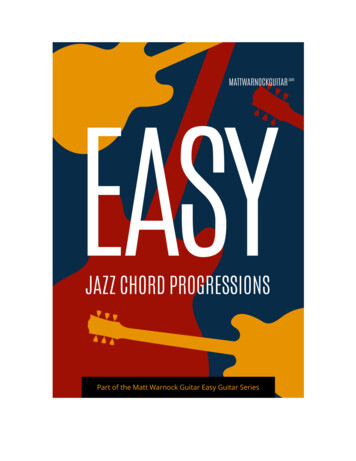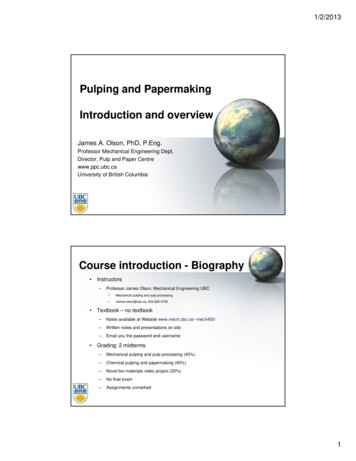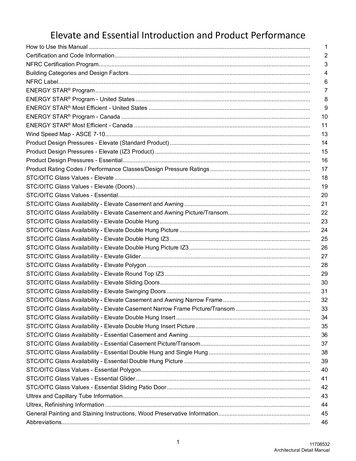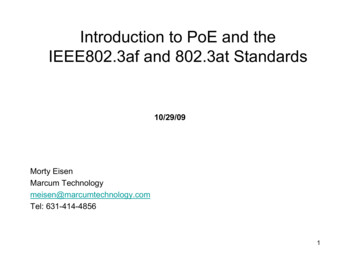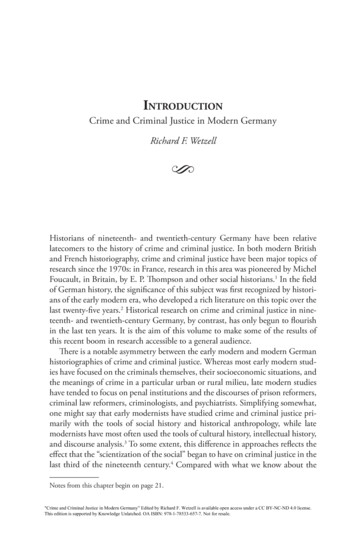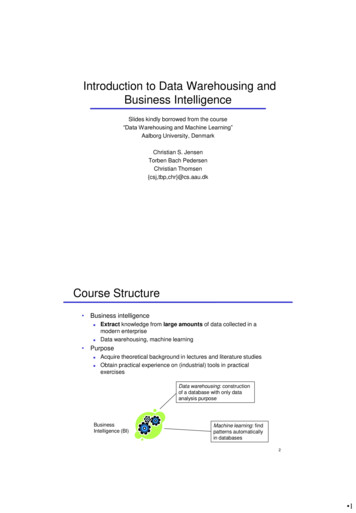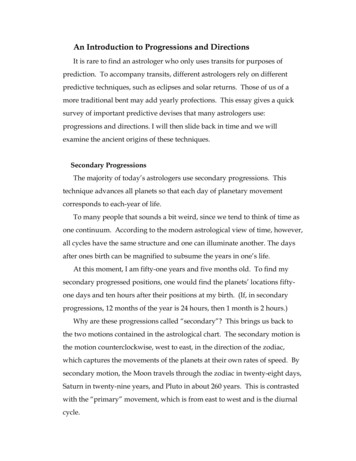
Transcription
An Introduction to Progressions and DirectionsIt is rare to find an astrologer who only uses transits for purposes ofprediction. To accompany transits, different astrologers rely on differentpredictive techniques, such as eclipses and solar returns. Those of us of amore traditional bent may add yearly profections. This essay gives a quicksurvey of important predictive devises that many astrologers use:progressions and directions. I will then slide back in time and we willexamine the ancient origins of these techniques.Secondary ProgressionsThe majority of today’s astrologers use secondary progressions. Thistechnique advances all planets so that each day of planetary movementcorresponds to each-year of life.To many people that sounds a bit weird, since we tend to think of time asone continuum. According to the modern astrological view of time, however,all cycles have the same structure and one can illuminate another. The daysafter ones birth can be magnified to subsume the years in one’s life.At this moment, I am fifty-one years and five months old. To find mysecondary progressed positions, one would find the planets’ locations fiftyone days and ten hours after their positions at my birth. (If, in secondaryprogressions, 12 months of the year is 24 hours, then 1 month is 2 hours.)Why are these progressions called “secondary”? This brings us back tothe two motions contained in the astrological chart. The secondary motion isthe motion counterclockwise, west to east, in the direction of the zodiac,which captures the movements of the planets at their own rates of speed. Bysecondary motion, the Moon travels through the zodiac in twenty-eight days,Saturn in twenty-nine years, and Pluto in about 260 years. This is contrastedwith the “primary” movement, which is from east to west and is the diurnalcycle.
I use the chart of Winston Churchill, for whom the different predictivetechniques that we examine yield interesting information.Here is his natal chart.We begin with his terrible year 1915. He was the Minister of theAdmiralty and was blamed for a botched attempt by England to end the FirstWorld War by a naval expedition through the Dardenelles. Eventually he had toleave the government and he spent the rest of the war outside of a policyposition, to his heartbreak. . Below is his progressed chart for this time.
Winston Churchill was forty years old during his terrible year; his secondaryprogressions would move all his planets forty days. Since his birthday was at theend of November the previous year, three hours to the middle of January 1915.Comparing this chart with Churchill’s natal chart, you will notice that theplanets from Jupiter and out move hardly at all; if in forty days they move but alittle, they will move just so little by progression. The Sun has moved roughlyone degree a year, from 7 Sagittarius to 18 Capricorn. Mercury had movedquickly, passing his Sun and now well ahead of it in the zodiac. Venus, havingturned retrograde and direct, is 11 degrees behind its position in the natal chart.The Moon, moving roughly a degree a month, conforming to its daily movementof about thirteen degrees a day, had gone around the zodiac once and was nowat the opposite sign from its natal position. .
Of these progressed positions, what is most interesting to us? During thisyear, progressed Moon was moving toward a square to Mars. After a sextile toVenus, Moon becomes conjunct Saturn, then opposite Uranus. The progressedMoon can give us the timing of occasions during the year.More important is that the Moon is in opposition to the progressedMidheaven, and also that the progressed Ascendant, conjunct Jupiter, opposesNeptune. The former can show a division between Churchill and authority –which is ironic because he was authority at that time – except that he lost his jobbeing the authority. The latter configuration pictures one whose grandiosity(Jupiter) is based on illusion and wrong thinking (Neptune).How do we calculate the progressed angles? I will hold off on that for now.Next we look at Churchill’s progressions for May 1940, when he became PrimeMinister of England and began to conduct his country’s war against Hitler.
There are many changes in Churchill’s life and by progression during thetwenty-five years between 1915 and 1940. In 1915, he was at the beginning ofa Sun-Moon cycle -- as Sun was in Capricorn and Moon moving away fromthe Sun in Aquarius. 1940, as you can see, is at toward the end this SunMoon cycle. (Churchill will have a progressed new Moon in mid-war.)In 1940, by progression, his Sun is involved with Saturn and Uranus, byconjunction and opposition. In 1915 it was his Moon. The Sun is the moreactive and intentional planet; displaying that Churchill was more in control ofhis own fate although facing enormous difficulties. Progressed Mercury,applying to Neptune by sextile, gives us some sense of the voice he was ableto give to the war effort.
Solar Arc DirectionsLet us now set up a contrast with Churchill’s solar arc directions for thistime in 1940. One will note that the Sun is in the same position as in hissecondary progressions for this time, but everything else is different.A direction is not just about cycles: we advance all planets and angles thesame distance as the Sun has moved by progression. When I turned fifty, theSun by progression had moved about the same number of degrees. By solararc, everything, from Ascendant to Saturn to Pluto, moves at the same speed.For secondary progressions one examines progressed positions and howthese positions aspect other progressed planets and angles. (Some astrologers,however, do look at progressed positions and their relationship to natalpositions similar to transits.) For solar arcs directions, the directed planetsand angles are always in the same positions relative to one another. Here weonly use aspects that directed positions make to natal positions. In the chartbelow, everything moves 66.5 degrees. You see that it is properly presentedas a biwheel with the natal chart.
What is interesting here? One sees here a major factor: the directedAscendant has moved to a conjunction with Sun, and the directed Midheavenforms a square to the Sun. The Ascendant and Midheaven are the two mostimportant personal points in the chart, summarizing the presence of thenative and his or her activity. Both positions contact his Sun, the planet ofleadership. Noting that Sun is also conjunct the fixed star Antares, this is aperfect configuration for one to become leader during warlike. Here we see amajor event in his life triggered by the arcing Ascendant and Midheaven.
Modern astrologers tend to use secondary progressions and solar arcdirections differently. Secondary progressions are often used to highlightturning points or climate changes in a person’s life: if a person’s Sun movesby progression from Aries to Taurus, gradually one will see this persons’ Suntaking on some Taurus qualities. These kinds of changes also occur when aplanet changes sign or is at a direct or retrograde station, or when an aspect(particularly between Sun and Moon) becomes exact. Solar arc directions aremore often used to predict discrete events, intentional or accidental. Whenone is unsure of a person’s birth time, solar arc directions are often used to“rectify” the chart by looking at the timing of singular events in a person’slife. When we look at the legacy ancient astrology we directions also used inboth ways.With solar arc directions, the movements of the Ascendant andMidheaven are the same as everything else. We find things more complexwhen we return to secondary progressions. This serves as a way to approachthe ancient tradition.Progressed Angles and AscensionsWhen I was first studying secondary progressions, a point of bewildermentarose: if the entire chart moves around during an entire day, why does theMidheaven progress about a degree a year and the Ascendant progresses anaverage of a degree a year? I thought that the angles would be constantlymoving, reflecting the moving angles going full circle in a day.It turns out that the progressed angles move not according to the secondarymotion through the zodiac but according to the primary -- diurnal -- motion.(The exception to this is Quotidian Secondary Progressions, which move theangles all the way around during a year and whose angles can be used to timespecific events during the year.)
How do we progress the angles according to the diurnal motion? The simpleanswer is by noting how many degrees cross the Midheaven during the time ittakes an area of the zodiac to rise -- to cross the line of the Ascendant.It takes about four minutes for a degree to cross the Midheaven, and a degreeequals one year of person’s life. But now the question becomes: a degree of what?The degrees over the Midheaven vary slightly – the Naibod method averagesout this variation so that the rate of change of the Midheaven is constantthroughout a day and, by progression, through a person’s years. Someastrologers use the average in zodiacal longitude; I use the more popularalternative, which averages the equatorial degrees: Right Ascension.The moving degrees of the Midheaven conform to how the time of day movesaccording to the rotation of the earth, which we measure by the terrestrialversion of Right Ascension – our familiar longitude. A planet in square by RA tothe Midheaven will take six hours to culminate: this is because one hour of timeis equivalent to fifteen degrees of Right Ascension, and fifteen times six gives aninety degree distance from the Midheaven. Our conventional time zones areapart by about fifteen degrees of longitude, to make up a 360-degree circle intwenty-four hours. If you want to calculate when the Sun will rise in Boston andin Los Angeles, subtract the longitudes of the two cities – their distance fromeach other from the reference of the Midheaven -- and multiply that by fourminutes for each degree of difference.Compared to the steady movement of degrees over the Midheaven, thedegrees of the Ascendant vary widely, based upon the location in the zodiac.“Ascensional times” are how many degrees cross the Midheaven during therising of a sign of the zodiac. They are called ascensional times because onedegree over the Midheaven equals four minutes of time, and fifteen degreesequals one hour.In the northern hemisphere, an Ascendant in Pisces and Aries rise in theshortest times, and are called signs of “shortest ascension”. Virgo and Libra rise
in the longest time and signs of “longest ascension”. The pairings ofAries/Pisces, Taurus/Aquarius, Gemini/Capricorn, Cancer/Sagittarius,Leo/Scorpio, and finally Virgo and Libra all rise in equal amounts of time, goingfrom the fewest to the most degrees over the Midheaven as they rise. Theancients called these “equally ascending zoidia,” and modern astrologer deemthese symmetries from the 0 Aries – 0 Libra axis “contra-antiscia.”Ascensional times also depend on the latitude of the place of birth. The closerone is to the equator, the closer are the ascensional times to one another; thefurther north or south, the further they will be apart.Churchill’s chart is a good illustration of higher latitudes, since he was born inthe 52nd parallel of latitude. If you look back at his solar arc directions for 1940,we advance all positions, including the Ascendant and Midheaven, by that of theprogressed Sun: 66.5 degrees. By secondary progression, however, Churchill’sAscendant has moved only 47 degrees! With an Ascendant at 00 Libra, thedegrees of the zodiac following his Ascendant will rise most slowly, equaledonly by those on the other side of 00 Libra, the last half of Virgo. If, however,Churchill was born with an Ascendant at 0 Aries, the Ascendant progressionwould move all the way into Gemini by the time he was twenty!Continuing our topic of the progressed ascendant, I now introduce anotherpossibility for directions: instead of directing by the progressed Sun, one coulddirect by the progressed Ascendant. This option is available in the Solar Firecomputer program. It is not popular but has an interesting rationale: theprimacy of the Ascendant itself in the natal chart. What is the symbolism of theAscendant?You should consider that the Ascendant itself is the place ofconnectedness between the rhythms of the sky and reality of our being on thisearth. One could say, in the spirit of the twentieth-century astrologer DaneRudhyar, that the Ascendant is the place of incarnation on this planet. TheAscendant serves well to be the reference for the beginning of our lives and, by
direction, for the end of our lives. For this to occur we need to compare theAscendant of birth with the necessary rhythms of the day cycle. This is whatusing ascensional times are doing.Churchill’s Ascendant-directed chart directs all positions 47 degrees, inconformity with the movement of his Ascendant at his latitude. Importantly, thisAscendant and also the Midheaven are configured with Mercury. During theprevious year, his Moon directed to degree of his natal Mars, denoting thebeginning of a warlike time for him. At the time Churchill became PrimeMinister, within a day, Venus directed to conjunct his Saturn: his personal lifewould be in cold storage for many years afterwards.The directed Ascendant , 47 degrees after the natal Ascendant, is onedegree past Mercury’s position, and in January, 1939, sixteen months beforebecoming Prime Minister, the Ascendant was exactly conjunct his natal Mercury.Midheaven was in exact square to his Mercury eight months earlier. About ayear before becoming Prime Minister, Ascendant-directed Moon moved to aconjunction with his natal Mars. Close to the day he became Prime Minister,Ascendant-directed Venus was conjunct Saturn. Unlike with Churchill’s solararc directions, one does not get discrete events from aspects becoming exact butthe beginning of different phases in his life. This is a factor that would st
predictive techniques, such as eclipses and solar returns. Those of us of a more traditional bent may add yearly profections. This essay gives a quick survey of important predictive devises that many astrologers use: progressions and directions. I will then slide back in time and we will examine the ancient origins of these techniques. Secondary Progressions The majority of today’s .

